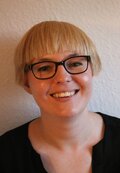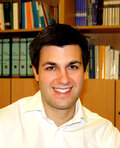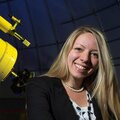People of the ERC

Prof. Dr. Ralf S. Klessen
is PI of STARLIGHT. He earned his doctorate at Heidelberg University with research activities conducted at the Max Planck Institute for Astronomy. Afterwards, he worked at Leiden Observatory and the University of California in Santa Cruz before he became head of the “Theory of Star Formation” Emmy Noether Junior Research Group at the Leibniz Institute for Astrophysics in Potsdam. He was appointed professor of theoretical astrophysics at Heidelberg University in 2006. Ralf S. Klessen is the deputy spokesperson of the CRC "The Milky Way System” and currently Dean of Studies of the Faculty of Physics and Astronomy.
Contact: Phone +49 6221 54 8978, klessen(at)zah.uni-heidelberg.de

Basma Klinger-Araifa
works as the ERC administrative assistant to Prof. Dr. Klessen. She is responsible for the ERC budget management and support of ERC employed scientists, guests and events. Her office is located at the Institute for Theoretical Physics at Albert-Ueberle-Str. 3-5. Her office hours are on Wed., Thurs. and Friday.
Contact: Phone +49 6221 54 4837, klinger-araifa(at)zah.uni-heidelberg.de

Dr. Jan-Pieter Paardekooper
has obtained his PhD 2010 at Leiden University, where he worked with Vincent Icke on the development of SimpleX, a radiative transfer code for ionising radiation. In addition, he looked at escape fractions of ionising radiation in high-redshift galaxies. In 2010 he moved to Sadegh Khochfar's TMoX group at MPE in Garching. There he studied the contribution of the first stars and galaxies to cosmic reionisation using cosmological hydrodynamics simulations of galaxy formation post-processed with radiative transfer. At ITA, he works in Ralf Klessen's research group to study the effect of photo-ionisation feedback on the formation of the first stars and galaxies.
Contact: Phone +49 6221 54 8967, paardekooper(at)uni-heidelberg.de

Dr. Claes-Erik Rydberg,
earned his PhD in January 2015 at Stockholm University. His doctor work was on the observability of the first metal free stars and the search for metal free galaxies using galaxy clusters as gravitational lenses. In the ERC group his work will focus on estimating the prospects of detecting supernovae from the first stars using different kinds of gravitational lenses. This has the potential to provide insight into what mass ranges the first stars formed and hence set constraints on the underlying physics.
Contact: phone +49 6221 54 6712, mail(at)utte.nu

Katharina M. J. Wollenberg, M.Sc.
has obtained her B.Sc. and M.Sc. from Ludwig Maximilian University of Munich. At University Observatory Munich she worked on galactic magnetic fields and on nonlinear structure formation in scalar-tensor gravity. Additionally, she received a postgraduate diploma in cosmology during her one year studies at University of Sussex, Brighton, UK. Since October 2014 she has been a PhD student in Ralf Klessen’s research group working in the ERC Grant “Starlight”. She studies primordial star formation using small-scale simulations with the Multiphysics simulation code FLASH and the multifrequency radiation-hydrodynamics code ZEUS-MP.
Contact: Phone +49 6221 54 48 28, wollenberg(at)uni-heidelberg.de

Dr. Erik Bertram
has studied physics as a junior student at Saarland University in Saarbrücken during his schooldays. Afterwards, he obtained his Bachelor and Master degree in 2010 and 2012 at the University of Heidelberg and his PhD in 2016. Bertram is working in Ralf Klessen's research group ERC Starlight and studies the effects of turbulence on the star formation process. Furthermore, he does radiative transfer calculations to connect the theoretical values to observational measurements.
Contact: Phone +49 6221 / 54 48 28, bertram(at)zah.uni-heidelberg.de

Anna T. P. Schauer
earned her master's degrees in both astronomy and physics at the LMU in Munich in the group of Andreas Burkert, where she has been working on simulations of early-type galaxies and observations of kinematic tracers. Since October 2014, she is a PhD student in Ralf Klessen's ERC research group. She studies feedback on first star formation with the goal of examining the interplay of different effects such as Lyman-Werner radiation, streaming velocities and X-rays using highly resolved simulations. Her further research interests include present day galaxy kinematics, first life, 21cm radiation and supermassive black hole formation. Anna Schauer is the student representative of the 10th IMPRS generation.
Contact: Phone: +49 6221 54 89 85, schauer(at)uni-heidelberg.de

Dr. Daniel Ceverino
is a member of Ralf Klessen’s Starlight group. He works on galaxy formation at high redshifts using cosmological hydro dynamical simulations, performed at the Leibniz-Rechenzentrum (LRZ) Supercomputing Centre. His general research interests include galaxy and star formation, as well as related feedback processes. His current project aims at the understanding of the first galaxies formed before the recombination era. These galaxies will be observed by future telescopes, like the James Webb Space Telescope (JWST) and this project will make detailed predictions about the properties of these first proto-galaxies.
Contact: Phone +49 6221 54 89 88, ceverino(at)uni-heidelberg.de

Carla June Bernhardt
earned her Bachelor of Science and Master of Science degrees from Brigham Young University, where she worked on modified methods of reverberation mapping of AGN. She is now a PhD student under the direction of Ralf Klessen, supported by 7the ERC Grant “Starlight”. She studies the origin and evolution of supermassive black holes at z > 6, less than a billion years after the big bang, with massively parallel cosmological simulations. She is also deriving synthetic observables in the NIR, Lyman-alpha and at 21 cm for these quasars to guide future surveys for their detection by JWST, the E-ELT, Euclid, WFIRST and the SKA.
Contact: Phone +49 6221 54 897, c.bernhardt (at) uni-heidelberg.de
Former members of the ERC

Tilman Hartwig
was a Master student in the group of Ralf Klessen who used numerical simulations to better understand the formation of the first stars. After he obtained his Master Degree in 2014, he continued his research in a collaboration with Volker Bromm in Austin, Texas on the statistics of the first stars. In October 2014 he started his PhD at the Institut d’Astrophysique de Paris under the supervision of Marta Volonteri. In his thesis he tries to improve our understanding of the formation and growth of the first supermassive black holes.
Contact: Phone +33 1 44 32 81 32, hartwig(at)iap.fr

Dr. Jennifer Schober
Jennifer Schober received her PhD from Heidelberg University in 2014. She worked with Ralf Klessen at the Center for Astronomy on magnetic field amplification via the turbulent small-scale dynamo during first star and galaxy formation. Her studies suggest that magnetic fields have rapidly reached saturation levels during early structure formation. In 2015 she joined Axel Brandenburg as a postdoctoral fellow at NORDITA in Stockholm where she works on chiral MHD in the early Universe.

Dr. Daniel J. Whalen
studies the birth and evolution of supermassive black holes (SMBHs) at very high redshift, about 400 million years after the Big Bang. In connection with SMBH birth he is also working on the evolution of supermassive primordial stars to find out how accretion and rotation determine their luminosities, temperatures and masses at collapse. He is also studying how supernovae from the first stars polluted the Universe with the heavy elements, which were necessary ingredients for subsequent generations of stars. He is also examining the potential use of galaxy clusters as cosmic telescopes to amplify light from ancient supernovae and galaxies in order to detect them with current or future observational facilities. Since February 2016 he holds a position as senior lecturer at the University of Portsmouth.
Contact: Phone +44 2392 843036, daniel.whalen(at) port.ac.uk

